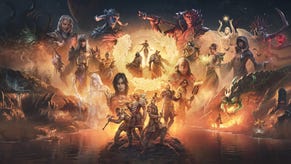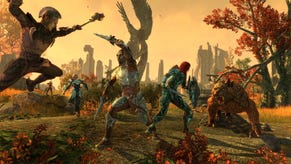Impressions: The Elder Scrolls Online
Scrolls To The Bottom
I don’t know what to tell you. My first few days in the Elder Scrolls Online universe have left me feeling very fed up. It was always going to be a tough job for Bethesda to recreate the awe and adventure of their single-player fantasy games for a mass(ively multiplayer) audience. But there was a hope that, actually, everything might turn out all right for fans. I’m sorry to say that, based on my 21 hours or so of questing, that hope should be laid to rest. You could say that 21 hours is short enough in MMO terms to be called a ‘gut reaction’. I suppose could have approached the game more scientifically, but to do that I would have had to measure my progress in ‘sighs per hour.’
It isn’t all bad.
There is a faithfulness to the world of the franchise that is very admirable, especially in terms of lore, but also in some of the game’s presentation. Simple things like the way you chat to NPCs and the ethical choices that appear during conversation will remind you that you are very much in Elder Scrolls territory. Not to mention some of the overlay, like the compass showing you where nearby places can be discovered. All the usual suspects are there – Khajit, Argonian, Norwegians – and all playable. The tension and interplay between the races seems to have been scaled down, at least judging from the questlines I followed, but the old traditions raise their heads: skooma as an addiction, Daedric Princes acting as tricksters, etc. But what you’re looking for in an Elder Scrolls game isn’t necessarily what you are looking for in an MMO. In an MMO you want solid, fun combat, interesting group questing mechanics and an enigmatic world to uncover. Is that what you get in TESO? I’m afraid the short answer is: no.
First, the world. The world map as shown here portrays an expansive continent, containing all of the other Elder Scrolls games combined.
It is a wonderfully attractive prospect. Of course, this being an MMO, your journey through the world has to be ‘gated’ in some way. By and large, MMO design is all about guiding the player in non-obvious ways down the path of least level resistance, especially in the early game. You send your players off on quests that will uncover bits of the world as they go, making their way steadily through the land, picking up storylines and fighting battles suited to their level. TESO follows this genre rule very obediently. And it is smart enough to place Wayshrines along these ‘paths’ that allow players to fast-travel between any previously discovered Wayshrine. Back and forth you go from your hometown to the frontier, selling your loot and repairing your armour, picking up quest along the way.
This all seemed very sensible to me at first, as far as game design goes. Until I realised that it’s the direct opposite to the opening hours of any modern Elder Scrolls single-player game, all of which give you a brief tutorial before summarily throwing you out into the world to do whatever the hell you want. To go wherever the hell you want. No such luck in the online cousin. The map of Tamriel is huge – but you cannot go wherever you want right from the start. My time has so far been confined to a series of increasingly large islands. There is a connecting ferry to the mainland, but it takes reaching level 12 (which took me till somewhere around the 20-hour mark) to be shown where this is. It is a frustrating reversal of what makes the single-player games so wonderful.
Maybe this is simply a problem of expectation and genre confusion. This is an MMO after all. One can have a massive world in this genre and leave some things off-limits, right? In fact, that’s how you encourage people to play on – to coax them onward through quest after quest, especially in the early hours. You let them know there is a huge world out there but you must earn your way out there.
Well, maybe. It just feels so restricted. There may be a huge world out there, yes. But the in-game map does not make it feel like it. If you are in a town, the map will give you a small, enclosed view of where you are. You can select another map to check out other destinations. But nothing on these other maps is labelled or hinted at. There is just a chunk of world, criss-crossed with uniformly pale roads and peppered with samey circular ruins, none of which have any real intrigue about them. If the game wanted to create a sense of adventurous exploration, it fails the moment it does not give you the desire to tramp off in the direction of a mysteriously-named cove, or a creepy-looking swamp. Or even just into the distance. As my cohort and reviewer-in-arms, Phill, pointed out to me as we played, there is so much gamefog clouding the environment that you begin to feel trapped in whatever township or fortress you are currently occupying, even if you are free to leave at any time. It is not much to ask of a series famed for its exploration to erect a visible, reachable mountain in the distance, or a vast forest, or an eerie, dried-up riverbed. Something (anything!) to peer at and say: That looks cool, let’s go there. Just about the only maps I did enjoy in the game were the treasure maps.
However, one big map does not an MMO make. Combat is important too. I have said in a previous hands-on that the developers have gone down the WoW route rather than the Elder Scrolls route as regards the brawling. New players will have to choose a weapon in which to specialise very early, as the ability to swap weapons with a button press is restricted to those beyond level 15. I played as a ranged character for most of my time and, though the bow felt powerful and useful as a weapon, it was irritating that I could not swap it for a dagger in the heat of battle. For example, whenever an enemy came close. Teamwork meant that my pal could take the heat off me as the tank but – beyond some buffing, dodging and basic counter-attacks – I found the combat to be a soulless barrage of button-tapping. A kind of dispassionate finger-twitch you develop in an effort to make enemy health bars drop faster. Despite the attempt to make the combat more physical (for example, with liberal use of area of effect attacks and blockable power strikes) you quickly revert to the standard brainlessness of cycling through the number keys until you find the combination of attacks that kills things fastest. I actually started to avoid fights, not because the enemies were too powerful or too numerous. Simply because it was so tedious. In a game were large chunks of your XP is supposed to come from slashing up millions of enemy mobs, this is not a good sign.
I could say it doesn’t matter too much. That the quests do not all involve fighting. There are many which are simply about intrigue and politicking. You can make up your XP by completing these. I could say this. But it would be a misleading piece of advice. The quests themselves are just as dull. Even in Elder Scrolls terms (a series not exactly famed for its abundance of personable characters), the stories told here are mind-numbing. When they are not as dull as old boots they are clichéd and full of ‘twists’. The person you are looking for has been mysteriously murdered. The family member you are saving from the fire/baddies/curse is the one responsible for the fire/baddies/curse in the first place. On and on these plots reappear, seemingly without end. There are only so many times you can end up in a jail cell before you begin to gnash your teeth with as much madness as an actual prisoner. This (along with the deeply uninspired puzzle elements often included) makes a lot of the missions just as shallow as any fetch quest. The whole experience is drier than a bowl of un-milked muesli.
Not so long ago I was sceptical about Wildstar and all its WoWish compulsions. I was put off by how standard it seemed. But now I can see that at least Wildstar tries to have a little fun, with its bouncey jumping, daft dialogue and floating islands full of player housing. TESO does have moments of light relief (one feline in the Khajit homelands keeps a caged Labrador, showing it off as a wild beast) but they are too few to truly relieve the drudgery of Yet Another Town Under Attack From Daedra.
The game’s best moments come when you pass through a town you have saved from some disaster a few quests ago and witness it being rebuilt now the threat is gone. And a lot has been done to avoid any quests about killing rats. (I stumbled across one. But I quickly refused, turned and walked away. It is very possible there was a ‘twist’ here. Maybe the rats were being released by the quest-givers rival? It is possible. But I was not going to take any chances). For all the other quests there is so little compunction to carry on with them, even in terms of levelling your shield ability or upgrading your armour. Likewise, much has been made of the skill tree and how it focuses not only on spells and skills but also on weapons, how it can branch out into different specialisations. But a closer inspection will reveal nothing special about this arrangement. You get skill points, you unlock skills, you add them to the task bar. None of my skills were especially interesting as a sneaky bowman. I could go invisible for 2.5 seconds with one of them. That was good.
PvP seems more promising. When you reach level ten you can disappear to Cyrodil to fight in the Alliance Wars (if you can find the option buried within the horribly confusing GUI). The three alliances – Aldmeri, Ebonheart and Daggerfall – are fighting for control of castles, forts, lumber mills and mines across a large map. I was lucky enough to witness a very scattered siege of one of the Aldmeri Dominion’s holdings. From my place on the battlements, I could see possibly 50+ players duking it out in the fields below the walls, while more of Our Lads were firing fireball after fireball from ballista and trebuchet down on the enemy. It was certainly the most excited I got during the whole playthrough. Then I got my bow out and realised that, at level ten, I did not have the range to fire at someone from this height, even if they were standing right below me.
Likewise, I had very little success in the subsequent counterattack on our foes fortress, for which I brought along my own ballista (this went sadly unused after I succumbed to the far-flung arrows from more experienced players). Likewise my sneaky jaunt behind enemy lines to discover some lesser-guarded castle ended in death by magic. The basic premise of the PvP area is that all Alliances are fighting over Elder Scrolls, which they capture from enemy strongholds and bring back to their homelands. These Scrolls grant boosts to all players in the alliance. For instance, our (only) Scroll in the Dominion gave us a delicious health boost, making us that little bit tougher. Of course, our main rival, the Daggerfall Covenant, had four Scrolls, granting them God-knows-what and making them the most feared hordes on the board. Whenever this happens the theory is that the other two Alliances will gang up and push back. This scrappy triumvirate is a very neat idea in terms of balancing the war, even if it is difficult to notice in the short term.
A scouting mission saw me going even deeper into enemy turf to make a report on a distant lumber mill – and I genuinely enjoyed this solo endeavour, sprinting through covered forests and avoiding the roads and castles. But when I completed the quest 45 minutes later I was frustrated by another one of TESOs greater flaws: its unholy stinginess. The amount of gold you receive in missions, or loot from the bodies of your enemies, is infinitesimally disappointing. In spite of that, it is only fair to say that I felt most adventurous in TESO when I was a nameless grunt in some grander military campaign, rather than being the Chosen One in greater Tamriel, along with five million others. Even though I am told this war of sieges is basically identical to the player battles of Guild Wars 2.
Back in the outer regions you can carry on playing without the threat of others but it won’t be long until you stumble across a bug of some description, including game-breakers. Vital objects in the world will become unusable, or simply disappear, meaning you have to log out and log back in again to reinstate them. Enemies will run at you swords ablaze, swing twice, scurry back to their patrol position, regen all their health and continue whatever box-lifting animation they were ensconced in before you attacked. This is not some spell they use. They just seem to forget you exist, mid-fight.
All in all, I cannot honestly recommend it. Even with the pitched, wavering skirmishes of PvP, I don’t really know who this game is for. It certainly doesn’t feel like it’s for Elder Scrolls fans. And MMO lovers will easily get their fix from more light-hearted alternatives. Alternatives, I should point out, which will not cost them £40 upfront, followed by a further £8.99 a month in subscription fees. My short playthrough was an excursion into drab and humourless world, full of people and things I really couldn’t bring myself to care about. It is obvious the quests have tried their best not to repeat the cardinal sins of other MMOs. But in doing so they only commit other, equally damning sins. Hackneyed dialogue, poor characterisation, a superficial sense of ‘threat’, and bugs. At its best The Elder Scrolls Online looks like a faithful addition to the lore. At its worst it is a derivative and uninventive anachronism. To me, it played sometimes like a Gameloft game. I actually feel nasty saying that. But I really don’t know what else to tell you.

















